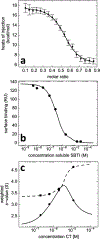Integration and global analysis of isothermal titration calorimetry data for studying macromolecular interactions
- PMID: 27055097
- PMCID: PMC7466939
- DOI: 10.1038/nprot.2016.044
Integration and global analysis of isothermal titration calorimetry data for studying macromolecular interactions
Abstract
Isothermal titration calorimetry (ITC) is a powerful and widely used method to measure the energetics of macromolecular interactions by recording a thermogram of differential heating power during a titration. However, traditional ITC analysis is limited by stochastic thermogram noise and by the limited information content of a single titration experiment. Here we present a protocol for bias-free thermogram integration based on automated shape analysis of the injection peaks, followed by combination of isotherms from different calorimetric titration experiments into a global analysis, statistical analysis of binding parameters and graphical presentation of the results. This is performed using the integrated public-domain software packages NITPIC, SEDPHAT and GUSSI. The recently developed low-noise thermogram integration approach and global analysis allow for more precise parameter estimates and more reliable quantification of multisite and multicomponent cooperative and competitive interactions. Titration experiments typically take 1-2.5 h each, and global analysis usually takes 10-20 min.
Conflict of interest statement
COMPETING FINANCIAL INTERESTS
The authors declare that they have no competing financial interests
Figures







References
-
- Robinson CV, Sali A & Baumeister W The molecular sociology of the cell. Nature 450, 973–82 (2007). - PubMed
-
- Cebecauer M, Spitaler M, Sergé A & Magee AI Signalling complexes and clusters: functional advantages and methodological hurdles. J. Cell Sci 123, 309–20 (2010). - PubMed
-
- Ladbury JE, Klebe G & Freire E Adding calorimetric data to decision making in lead discovery: a hot tip. Nat. Rev. Drug Discov 9, 23–7 (2010). - PubMed
-
- Chaires JB Calorimetry and thermodynamics in drug design. Annu. Rev. Biophys 37, 135–51 (2008). - PubMed
Publication types
MeSH terms
Substances
Grants and funding
LinkOut - more resources
Full Text Sources
Other Literature Sources

